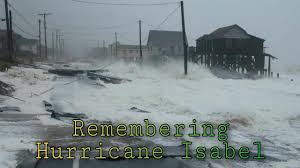On September 19, 2003, Hurricane Isabel made landfall near Cape Hatteras, North Carolina, and proceeded to unleash its destructive force on the East Coast of the United States. As the storm moved northward, it brought heavy rain, strong winds, and widespread devastation to the Washington D.C. metropolitan area. Hurricane Isabel was a powerful Category 2 storm that had already caused significant damage along its path before reaching the nation's capital. As it made its way towards Washington D.C., the city braced for the impact, with residents and authorities taking necessary precautions to ensure the safety of the population. On the evening of September 18, 2003, the outer bands of Hurricane Isabel began to lash the Washington D.C. area with heavy rain and gusty winds. As the storm intensified, the effects became more severe, with sustained winds reaching up to 70 miles per hour and gusts exceeding 100 miles per hour in some areas. The combination of high winds and heavy rainfall caused widespread damage throughout the region. Trees were uprooted, power lines were downed, and buildings suffered structural damage. Flooding was also a major concern, as the storm surge and rainfall overwhelmed drainage systems and caused water levels to rise rapidly. The impact of Hurricane Isabel on Washington D.C. was particularly notable due to the city's unique geography. The Potomac River, which runs through the heart of the capital, was prone to flooding during severe weather events. As the storm surge pushed water upstream, parts of the city experienced significant flooding, including the iconic Georgetown neighborhood. The storm's impact on infrastructure was severe, with widespread power outages affecting millions of people in the region. Utility companies worked tirelessly to restore electricity, but it took days and, in some cases, weeks for power to be fully restored. The lack of electricity posed challenges for residents, businesses, and emergency response efforts. In the aftermath of Hurricane Isabel, the Washington D.C. metropolitan area faced a long and arduous recovery process. Cleanup efforts were launched to remove fallen trees, debris, and repair damaged infrastructure. Residents and businesses worked together to rebuild and restore normalcy to their communities. The impact of Hurricane Isabel on Washington D.C. served as a stark reminder of the vulnerability of coastal cities to severe weather events. The storm highlighted the importance of disaster preparedness, including early warning systems, evacuation plans, and infrastructure resilience. In the years following Hurricane Isabel, Washington D.C. and its surrounding areas have made significant investments in improving emergency response capabilities and infrastructure. Efforts have been made to strengthen buildings, upgrade drainage systems, and enhance communication networks to better withstand future storms. September 19, 2003, will always be remembered as the day when Hurricane Isabel struck Washington D.C. and left a lasting impact on the city and its residents. The storm served as a reminder of the power of nature and the need for communities to come together and support one another in times of crisis. The lessons learned from Hurricane Isabel continue to shape the region's approach to disaster preparedness and recovery, ensuring that the nation's capital is better equipped to face future challenges.
19 Sept, 2003 U.S.A. Hurricane Isabel Strikes Washington DC
